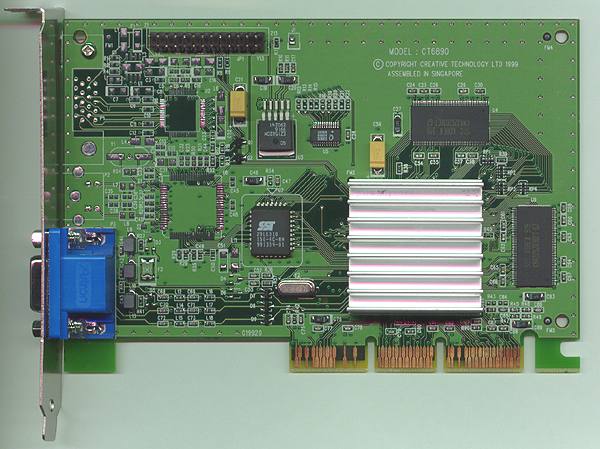Riva TNT2 M64

TNT had the old 0.35 µm technology and was already discontinued. Also, the Riva TNT chips have been sold and Nvidia doesn't care where the graphics card makers put them. And I want money. Therefore, it was possible to offer a modified version of Riva TNT2 at a lower price, playing on the popular name.
First of all, what was the Riva TNT2 M64? This is a type of chip that has 64-bit memory access. Like this. The graphics core is 128 bit and the memory access is 64 bit. Due to this, you can significantly reduce the price of the M64. Let's look at its characteristics.
Specifications NVIDIA Riva TNT 2 M64
| Name | Riva TNT 2 M64 |
| Core | NV5 |
| Process technology (µm) | 0.25 |
| Transistors (million) | 10.5~15 |
| Core frequency | 125 |
| Memory frequency (DDR) | 150 |
| Bus and memory type | SDR-64bit |
| Bandwidth (Gb/s) | 1.2 |
| Pixel pipelines | 2 |
| TMU per conveyor | 1 |
| textures per clock | 2 |
| textures per pass | ? |
| Vertex conveyors | No |
| Pixel Shaders | No |
| Vertex Shaders | No |
| Fill Rate (Mpix/s) | 250 |
| Fill Rate (Mtex/s) | 250 |
| DirectX | 6.0 |
| Anti-Aliasing (Max) | No (?) |
| Anisotropic Filtering (Max) | No (?) |
| Memory | 32MB |
| Interface | AGP4x |
| RAMDAC | 300MHz |
Features are similar to Riva TNT2. Except for 64 bit memory access. Also, Riva TNT2 M64 did not support SGRAM.

The speed in 2D was lower, as it depends on the speed of interaction between the video chip and memory. This is especially noticeable at high resolutions. When switching from 16-bit to 32-bit color, the speed drop increases. In addition, the speed drops very much when the resolution is increased. All this also applies to 3D applications, where the speed drop is more significant.
Support for up to 32 megabytes of memory versus 16 for TNT.
Operation at frequencies 125/150 MHz versus 90/110 for TNT
AGP4x support
This is exactly what was emphasized when selling Riva TNT2 M64.
Riva TNT2 M64 based cards could be overclocked up to 145/180 MHz. But even in this case, they could not catch up in speed with Riva TNT2. In the non-overclocked state Riva TNT2 M64 could not compete even with the overclocked TNT. However, 32 megabytes of memory meant good work with large textures. Who was the Riva TNT2 M64 for? For those who did not understand bits and bytes, who will pay attention to the name TNT2, 32 megabytes of memory and low price. For those who prefer to work in 2D but still have pretty good power for 3D games in between. Undoubtedly, Riva TNT2 M64 has found its customers. Cards based on Riva TNT2 M64 are often confused with cards based on Riva TNT2 Vanta. But it was not the only solution for the market of cheap products. nVidia Riva TNT2 Vanta is the second representative of cheap nVidia solutions.



